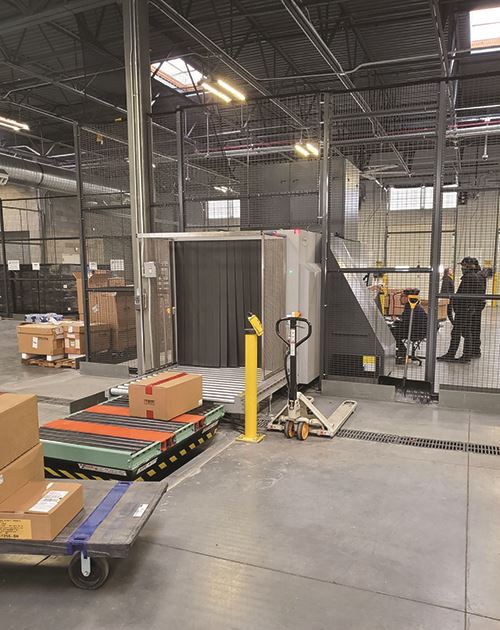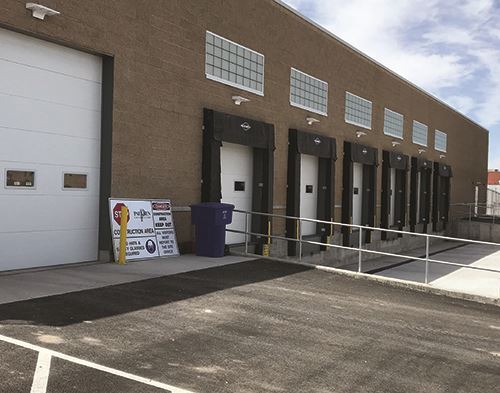New Receiving & Distribution Center Improves the Way Goods Move Through Salt Lake City Int’l

Salt Lake City International Airport (SLC) is changing the way people and goods travel through its facilities. A multiphase effort to address its changing operational needs began with an airport redevelopment program that focused on passenger flow, and a $5.6 million Central Receiving and Distribution Center (CRDC) that opened last August is enhancing the safety, security and efficiency of how goods move throughout SLC.
 Management and security staff keyed into a common industry concern: airside vehicle traffic nearly 24 hours a day. With the help of Bradford Airport Logistics, SLC leaders took action to understand and address this risk in a holistic manner.
Management and security staff keyed into a common industry concern: airside vehicle traffic nearly 24 hours a day. With the help of Bradford Airport Logistics, SLC leaders took action to understand and address this risk in a holistic manner.
“Essentially, what we wanted to do was to get vehicle traffic off the ramp and gates,” explains Shane Andreasen, director of Administration and Commercial Services for the Salt Lake City Department of Airports. “This ultimately enhances the safety and security of our airfield and surrounding assets.”
|
facts&figures Project: Central Receiving & Distribution Center Location: Salt Lake City Int’l Airport Size: 22,000 sq. ft. Loading Docks: 7 Cost: $5.6 million Opened: Aug. 2020 Staffing: 15 Facility Operator: Bradford Airport Logistics Operating Contract: $1.7 million/year for 5 years Facility Design: GSBS Architects General Contractor: Paulsen Construction Green Features: Robust recycling program; electric (vs. gas-powered) trucks Of Note: Airport & Bradford Logistics collect excess food from concessionaires for local food banks. |
After completely reconsidering how goods could move through the airport, the project team determined that a central facility was the best option to manage the inflow and outflow of essential everyday products. The 22,000-square-foot CRDC that was subsequently established allows the airport to screen, sort and deliver all products throughout its terminals and concourses, while still meeting the time-sensitive needs of its vendors and tenants.
Limiting access to sensitive areas of the airport by vendors and non-airline operators prior to screening was a paramount priority for the project design team. All vehicles now are re-routed away from sensitive areas and to the CRDC.
Designers overhauled a former cargo building located near the terminal area to create a new facility for the trucks and processing equipment that screen and distribute thousands of products needed at SLC every day. A special CRDC team manages the complex logistics, pushing goods out through seven loading docks to trucks that deliver them throughout the airport campus. Drive time from the facility to the airport is just five minutes.
Worth the Cost?
“Fewer vehicles driving on the airfield results in a reduction in the number of delays and other issues caused by vehicle traffic on the ramp and on the roadways,” says Benjamin Richter, chief executive officer and founder of Bradford Airport Logistics. “This one change can impact customers and airport revenue.”
The 15-member CRDC team, managed by Bradford Airport Logistics, performs regulatory inspections and screens goods with X-ray machines before consolidating them for redistribution to SLC’s terminal and two concourses. The process is used for a wide variety of products, including supplies for operations staff and airline tenants, as well as food, beverage and retail items for airport concessionaires.
 Richter notes that at most airports, tenants operate independently from each other and the airport, which is not efficient or secure. Redundant and frequent operations within the facilities also can put stress on the airport systems, he adds. SLC is seeing and experiencing the benefits of bringing all airport and concessionaire products together under one roof to streamline screening and handling logistics.
Richter notes that at most airports, tenants operate independently from each other and the airport, which is not efficient or secure. Redundant and frequent operations within the facilities also can put stress on the airport systems, he adds. SLC is seeing and experiencing the benefits of bringing all airport and concessionaire products together under one roof to streamline screening and handling logistics.
When SLC issued a request for proposals regarding its receiving and distribution system, Bradford Airport Logistics stood out with more than 20 years’ experience in complex airport environments such as Detroit’s Metropolitan Wayne County Airport. Through a competitive bid process, SLC hired the firm in April 2019 at a cost of $1.7 million per year for five years.
“One of the biggest criteria we considered in choosing Bradford Airport Logistics was the experience of the operator,” says Andreasen. “We didn’t want someone who was not familiar with airports.” Operating costs and sustainability were other main factors, he adds.
Bradford Airport Logistics worked closely with SLC design and operations teams to develop a plan to bring a new concept for receiving and distribution to fruition. Part of the planning process included making site visits with other airports, such as San Diego International, with similar facilities.
The concept of centralizing the receipt and distribution of goods is not new to the airport industry. About 20 years ago, CRDCs became popular in Europe, and then the model spread to the U.S. Studying existing facilities provided SLC with insight about what features to incorporate into its new facility.

Green Goals
With sustainability goals figuring prominently into the airport’s multiphase improvement strategy, the project team determined that it wanted the new CRDC to use electric vehicles and include a robust recycling program. Ultimately, the airport hopes to achieve LEED Gold certification for the new facility.
Bradford Airport Logistics checked all of the boxes that SLC wanted to address. “In this industry we are often criticized about sustainability efforts,” Richter reflects. “We understand the criticism and have the imagination to overcome those challenges to deliver on an airport’s vision.”
The Bradford team developed a sustainability program that incorporates enhanced recycling and pre-ordered electric semi-trucks from Tesla and cab-over trucks by Peterbilt. Richter notes that the team will add even more sustainability components to its plan at SLC’s request.

Built-in Flexibility
In order to reinvent the way goods are handled at SLC, the airport needed buy-in from tenants and other support partners to make the new processes effective.
“Our goal was to get all ancillary traffic off the airfield,” Andreasen explains. “And to reach that goal, we needed the support of everyone—airlines, concessionnaires, mail services, vendors and suppliers.”
As a result, the plan needed to make the switch had to be very detailed. For instance, the project team had to determine how ice should be delivered, how vending machines would be restocked and even how mail would be picked up. SLC worked closely with stakeholders to develop a process that would meet their specific needs. For example, it added mail drop boxes around the airport, and provided tenants and employees with a detailed pick up and drop off schedule.
The project team credits strong partnerships with stakeholders as a crucial element to making the complex system work. Importantly, SLC built in the opportunity for tenants to give feedback to it and Bradford.
“We decided that if a change causes a negative impact, then it presents a problem for SLC, and we need to fix it,” explains Andreasen. “This means we can’t be too rigid in our processes and need adjustments over time to make this work.”
He reports that airport partners continue to work closely to develop effective solutions for how goods are transported at SLC, while managing costs and keeping sustainability goals at the forefront. The result is significantly fewer vehicles in secure airside areas, and more effective and efficient management of goods flowing through the airport.
“Forward-thinking airports are doing things differently,” adds Richter.
|
Distributing Food to Those in Need When personnel at Salt Lake City International Airport (SLC) expressed concern about food insecurity within their communities, management turned to the contractor that manages the airport’s new Central Receiving and Distribution Center (CRDC) to help funnel unsold food from airport concessionaires to local food banks. Bradford Airport Logistics, which prides itself in surpassing each customer’s expectations, was all in. “When we are contracted for a project, we’re an integrated partner and willing to go outside the scope of our contract to meet the needs of our airport clients,” explains Benjamin Richter, the company’s chief executive officer and founder. Bradford developed a plan that will encourage SLC concessionaires to bring their non-salable, but still edible, food to a secure storage cooler in the terminal. Every day, its employees will take food from the concourses to the CRDC for immediate distribution to Salt Lake City Mission, which will then distribute it to local food banks. While “food recycling” was not part of the original work scope for Bradford, the company was happy to take on the extra task. “We don’t shy away from opportunities,” says Richter. “When an airport wants to lead in the community, like SLC is, we, in turn, want to work with them to lean into new ideas and bring them to life.” In early June, the effort was on hold until pandemic-suppressed concessions traffic and associated food surpluses return to normal. A few years ago, HMSHost ran a similar program at SLC. It donated about 1,000 pounds of food such as packaged sandwiches, fruit cups and parfaits to the mission every month. |
2022 Charlotte Douglas International Airport Report of Achievement
 Giving back to the community is central to what Charlotte Douglas International Airport and its operator, the City of Charlotte Aviation Department, is about, and last year was no different.
Giving back to the community is central to what Charlotte Douglas International Airport and its operator, the City of Charlotte Aviation Department, is about, and last year was no different.
Throughout 2022, while recovering from the COVID-19 pandemic, we continued our efforts to have a positive impact on the Charlotte community. Of particular note, we spent the year sharing stories of how Connections Don't Just Happen at the Terminal - from creating homeownership and employment opportunities to supporting economic growth through small-business development and offering outreach programs to help residents understand the Airport better.
This whitepaper highlights the construction projects, initiatives, programs and events that validate Charlotte Douglas as a premier airport.
Download the whitepaper: 2022 Charlotte Douglas International Airport Report of Achievement.








